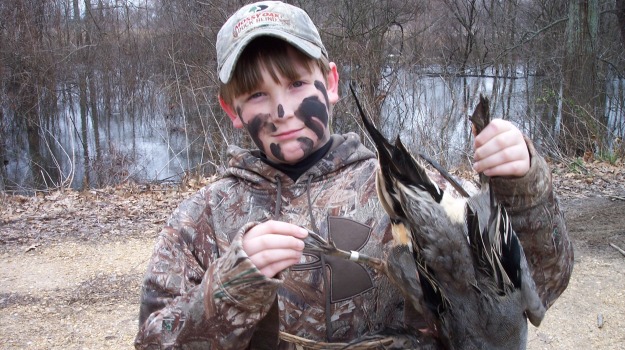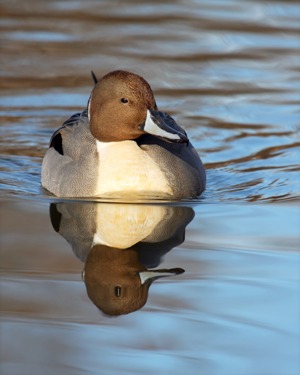
Teaching the “Big Picture” on Managing Wildlife
By Jason Patterson
As I write this the mid-south is experiencing a nasty drought. Heat and very little rainfall are taking their toll. Finally during the past week we are starting to see a little rain which is a welcome site to us Gamekeepers. My profile includes being a father, a gamekeeper and someone who values and lives the Mossy Oak lifestyle. I live in Jackson, Tennessee, and I am the Regional Pro-Staff Manager for Mossy Oak, overseeing the Mississippi Flyway Waterfowl Team.
I wanted to share a short story with all of you about hunting with youth and involving them in the Gamekeeper lifestyle. This is a very special story, a rare story that happened to bless me on the last day of Tennessee’s juvenile waterfowl season. Waterfowl season across the country last year was sporadic to say the least, with unseasonably warm weather dominating most of the season. Early rainfall raised river levels and filled up most of the fields and pot holes - waterfowl were spread everywhere, which in turn, caused hunting to be slow overall. Flooding right before the season had crops washed away, navigation dangerous and areas we once hunted before were impossible to get to. Pits were under water and crop fields were covered as well. Waterfowl had to search for areas to feed where they could actually reach their food.
Waterfowl hunting is a way of life for a lot of us, it drives us to do some crazy things - sleep deprivation, late nights, tedious work on decoys, gadgets, and most of us look forward to that “torture” each year.
A friend of mine has a small lease in Lauderdale County in Northwest Tennessee that covers about 100 acres. The blind consists of your standard eight man pit, all your novelty items of course; stove, couches and plenty of food for us to consume (and yes, that is a necessity for us hunters in the south). The property is managed to benefit the waterfowl and migratory birds that travel down the Mississippi flyway. Corn is planted surrounding the pits, with several holes cut out for shooting opportunities. Outside the corn, watering areas are maintained with tall grasses and millet. Flooded wood lots adjacent to the fields provide sanctuary for resting birds. Truly a set up that benefits all the needs of waterfowl.
Migratory waterfowl need two things besides the obvious water, and something you need to look for when you manage your property or look for areas to hunt; food and a place to get away from the gunfire.
My friend called me and asked if I wanted to bring my 12 year old son Oakley, to hunt with them on the final day of juvenile season. In Tennessee the juvenile season is the weekend following the end of our regular season. The TWRA (Tennessee Wildlife Resources Agency), which manages the wildlife in Tennessee, hit this one on the head when they set this season. There are lots of waterfowl in the area during this time and it provides great hunting for the youth involved.
 As we waded to the pit that morning we had four young boys along for the hunt. I would do the calling and my friend would help with everything else involved with handling four teenage boys. The day started cold and clear, with a slight breeze, a perfect set up for the morning. Waterfowl were already up and flying to the corn fields to feed. I started to coax some birds our way and several “lookers” broke off. Shots rang out and a variety of birds were taken - mallards, teal, gadwalls and a Canada goose as well.
As we waded to the pit that morning we had four young boys along for the hunt. I would do the calling and my friend would help with everything else involved with handling four teenage boys. The day started cold and clear, with a slight breeze, a perfect set up for the morning. Waterfowl were already up and flying to the corn fields to feed. I started to coax some birds our way and several “lookers” broke off. Shots rang out and a variety of birds were taken - mallards, teal, gadwalls and a Canada goose as well.
There were three birds in particular that stood out and will never leave my memory. I was working a set of three pintails off of the right side of the blind, they made several passes and were working well. On the fourth pass they cut the right side of the blind and provided a shot. Four boys, all in face paint were waiting with anticipation. I called the shot - Oakley jumped up, snapped off a shot and a pintail folded. The other boys followed suit and dropped two more behind us.
This is where it gets interesting. One of the boys got out of the blind to retrieve the first bird my son shot and remarked, “Its got something shiny on its leg.” We all just looked at each other in a blank stare for a moment. Low and behold, the pintail drake had a band. After several pictures and a celebration of the hunt, all in all they harvested 11 birds that day and had a great time.
I have hunted waterfowl for 20 years and have never witnessed anyone harvest a band…but now my son has one. Even more interesting, and a testimony for all the organizations involved with managing wildlife, the numbers were worn off the band completely. I had to send the band off to the bird banding laboratory in Maryland so they could actually read it. They have the means of dipping the band in a solution to make the numbers stand out so you can read them.
After weeks of waiting and my son asking me every day if I had received the info, the email arrived with the information on the band. The bird was banded in 2001, in Pipestone, Manitoba, Canada. It was hatched in 2000 or earlier. This bird was over 12 years old and a true testimony of what management has done for all hunters and people who love the outdoors. This was a great lesson; to see how the efforts of a few people working together can improve the outdoors for all.
It’s vital that anyone who harvests a banded bird, either leg band or neck ring, reports it back to our wildlife agencies. The data show biologists how the harvest is spread throughout each flyway. Biologists use this information to estimate annual harvest rates and even annual survival rates for some waterfowl species. The difference in annual harvest and survival rates has helped biologists understand how breeding habitat conditions and harvest regulations affect survival.
The first large-scale banding program was established in 1922, but it was not until 1946 that several countries got together and an international banding effort was organized. One of the first uses of the banding and recovery data was to simply aid biologists in determining the major migration paths. By banding ducks and geese in the northern breeding areas and then marking the points where hunters and others recovered them, biologists were able to identify the four major migratory flyways across North America.
This is a trophy that neither, my son, or I, will ever forget. Being a father, I would trade every animal I have harvested to see a youth smile each time they’re able to take one. Everyone should take the opportunity to get youth involved in “our way of life,” the Mossy Oak Gamekeepers way of life! Bring them along to help you with your food plots, feeding program, fishing, it doesn’t matter just get them outdoors. The joy you will get from seeing a child smile will put an imprint on you for the rest of your days. We need future gamekeepers to carry on our legacy and to carry on the hunting and fishing tradition.
Duck photo credit: Teekaygee | Dreamstime.com




























